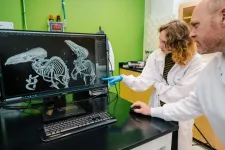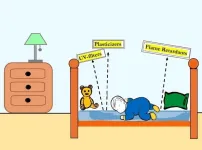(Press-News.org) Newly published research from UNC Greensboro biology professor Dr. Bryan McLean and colleagues shows that the masked shrew, a small, mole-like mammal found in the Appalachian Mountains, shrinks its body and braincase to conserve energy during winter months. The study, published in the May 2025 issue of The American Naturalist, found that the masked shrew (Sorex cinereus) reduces its body mass by 13 percent in the colder months; the creature then grows larger in spring when conditions improve. In addition to a shrinking body, the team also found seasonal changes in the height of the creature’s braincase (the portion of the skull that houses and protects the brain) and the length of the femur. “Shrinking the body and its parts is in fact a clever survival strategy,” says McLean. “And it’s one that’s important for us to understand as mammals face a constantly changing planet.” Known as Dehnel’s phenomenon, this seasonal shrinking has been observed in other mammals but most often in shrews, which are small, insect-eating animals unrelated to rodents. Dehnel’s phenomenon is an extreme example of “phenotypic plasticity” – the ability of an organism to alter its physical form in response to environmental changes. “We don’t know how common Dehnel’s phenomenon is among mammals, but we know it is rarer in nature than other energy-saving strategies mammals use, like hibernation,” said McLean. McLean and his team of graduate and undergraduate students analyzed 125 masked shews that were trapped in North Carolina’s Pisgah National Forest from 2021 to 2023. The team used “pitfall traps” buried in leaf litter to capture the shrews. The animals were weighed in the field, then brought to UNCG’s Joint School of Nanoscience and Nanotechnology for microCT scans to examine various skeletal dimensions. Specimens and associated data are archived in the UNCG Mammal Collection. Researchers from Georgia Southern University were also involved in the research. “Our population of masked shrews is the southern-most yet studied for these multiple different traits,” said McLean, “and the femur measurements we made are the first to show the magnitude of seasonal change in the long bones of the skeleton. This shows that shrews rapidly remodel much of their skeleton.” Most prior studies of the phenomenon come from Europe. To place their new results in context, the researchers also conducted a meta-analysis of 74 other studies from across the Northern Hemisphere, combining that research with their own findings to understand what factors drive Dehnel’s phenomenon. McLean and his team developed statistical models that accurately predicted the amount of body shrinkage they observed based solely on the climate at the North Carolina site. “This analysis reveals the generality of Dehnel’s phenomenon in Sorex shrews,” explains McLean. “Across many populations of shrews on three continents, the degree of body mass and braincase height shrinkage is greatest in areas with the lowest cool-season temperatures. So, fall and winter temperatures predict Dehnel’s phenomenon in these animals.” “Phenotypic plasticity is a key way that shrews and many other species respond to changes in temperature,” McLean notes. “By learning more about this process, we can start to understand how mammals buffer against rapidly changing climates.”
END
New UNCG research shows southern shrews shrink in winter
2025-04-15
ELSE PRESS RELEASES FROM THIS DATE:
Children exposed to brain-harming chemicals while sleeping
2025-04-15
Babies and young children may breathe and absorb plasticizers called phthalates, flame retardants, and other harmful chemicals from their mattresses while they sleep, according to a pair of peer-reviewed studies published today from the University of Toronto in Environmental Science & Technology and Environmental Science & Technology Letters. These chemicals are linked to neurological and reproductive problems, asthma, hormone disruption, and cancer.
"Sleep is vital for brain development, ...
Emotions and levels of threat affect communities’ resilience during extreme events
2025-04-15
Hoboken, N.J., April 14, 2025 — Tightly connected communities tend to be more resilient when facing extreme events such as earthquakes, hurricanes, floods or wildfires, says Jose Ramirez-Marquez, who develops metrics to analyze, quantify and ultimately improve performance of urban systems.
Ramirez-Marquez, associate professor and division director of Enterprise Science and Engineering at Stevens, who grew up in the earthquake-prone Mexico City knows this first-hand. “Whenever there's an earthquake, a city-wide alarm goes off and everybody leaves wherever they are and stays in the middle of the street — that’s a prevention phase,” he says. ...
New CONSORT reporting guidelines published today in five medical journals
2025-04-14
Under embargo until 23:30 (UK), Monday April 14, 2025
An updated set of guidelines to improve transparency and clarity in the reporting of randomised controlled trials have been published today. The CONSORT (Consolidated Standards of Reporting Trials) 2025 statement provides a minimum set of essential items that should be included when reporting the results of randomised trials.
First published in 1996, the CONSORT guidelines saw additional updates in 2001 and 2010. Becoming the gold standard for reporting randomised trials, ...
Experts stress importance of vaccination amidst measles outbreaks
2025-04-14
Pediatric infectious diseases experts stress the importance of vaccination against measles, one of the most contagious viruses, which is once more spreading in the United States. In the article published in Pediatrics, they update pediatricians on this vaccine-preventable disease, which was previously declared non-endemic in the U.S.
“The most effective way to prevent measles is vaccination,” said lead author Caitlin Naureckas Li, MD MHQS, infectious diseases specialist at Ann & Robert H. Lurie Children’s Hospital of Chicago and Assistant Professor of Pediatrics at Northwestern University ...
Enabling stroke victims to 'speak': $19 million toward brain implants to be built at U-M
2025-04-14
Images
A new collaboration between the University of Michigan and Stanford University aims to give stroke patients the ability to "speak" by detecting and interpreting brain signals, using the world's smallest computers linked up to the world's most biocompatible sensors.
The Marcus Foundation announced today a $29.7 million grant, led by Stanford, that would benefit victims of aphasic stroke, who are often left struggling to communicate. U-M will receive $19 million of the total grant.
According to the American Heart Association, stroke is the leading cause of disability in the ...
Study captures sharp uptake in use of new weight loss and glucose-lowering medications
2025-04-14
When it comes to managing weight loss and type 2 diabetes with medications, research shows that it’s out with the old and in with the new. Investigators from Mass General Brigham looked at claims data from nearly 2 million people between 2021 and 2023 and their findings highlight a shifting landscape for weight loss and glucose managing medications. Those changes include a sharp climb in the use of newly approved medications, especially tirzepatide, which is sold under the brand name Mounjaro for diabetes treatment and Zepbound for weight loss. The use of medications previously common in the treatment of type 2 diabetes, including metformin, sulfonylureas, and insulin, decreased. Results ...
Van Andel Institute to recognize Dr. J. Timothy Greenamyre with 2025 Jay Van Andel Award for Outstanding Achievement in Parkinson’s Disease Research
2025-04-14
GRAND RAPIDS, Mich. (April 14, 2025) — Van Andel Institute has named renowned physician-scientist J. Timothy Greenamyre, M.D., Ph.D., as recipient of its 2025 Jay Van Andel Award for Outstanding Achievement in Parkinson’s Disease Research.
The award will be presented during Grand Challenges in Parkinson’s Disease, VAI’s flagship annual Parkinson’s disease symposium, Sept. 9–10, 2025.
Greenamyre’s pioneering research into the interactions between genes and the environment has vastly improved our understanding of Parkinson’s development and progression. He has published more than 200 articles detailing ...
One firearm injury was treated every 30 minutes in emergency departments in a study of 10 jurisdictions
2025-04-14
Embargoed for release until 5:00 p.m. ET on Monday 14 April 2025
Follow @Annalsofim on X, Facebook, Instagram, Threads, and LinkedIn
Below please find summaries of new articles that will be published in the next issue of Annals of Internal Medicine. The summaries are not intended to substitute for the full articles as a source of information. This information is under strict embargo and by taking it into possession, media representatives are committing to the terms of the embargo not only on their own behalf, but also on behalf of the organization they represent.
----------------------------
1. ...
The gut health benefits of sauerkraut
2025-04-14
Is sauerkraut more than just a tangy topping? A new University of California, Davis, study published in Applied and Environmental Microbiology suggests that the fermented cabbage could help protect your gut, which is an essential part of overall health, supporting digestion and protecting against illness.
Authors Maria Marco, professor with the Department of Food Science and Technology, and Lei Wei, a postdoctoral researcher in Marco’s lab, looked at what happens during fermentation — specifically, how the metabolites ...
Children’s Hospital of Philadelphia researchers chart natural history of patients with SCN8A-related disorders
2025-04-14
Philadelphia, April 14, 2024 – Researchers from the Epilepsy Neurogenetics Initiative (ENGIN) at Children’s Hospital of Philadelphia (CHOP) have completed a comprehensive natural history study of SCN8A-related disorders, which represent a spectrum of neurological symptoms. The study, using retrospective clinical information analyzed through novel data analysis methods, revealed a range of seizure types and neurodevelopmental features, and identifies potential targets for future clinical trials. The findings were published online on April 14, 2025, in Neurology®, the medical journal ...


